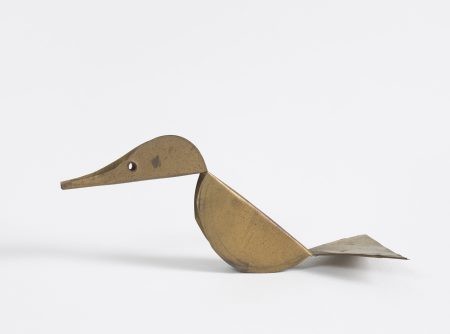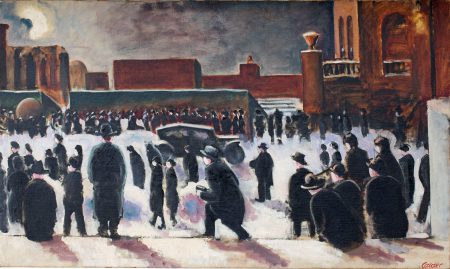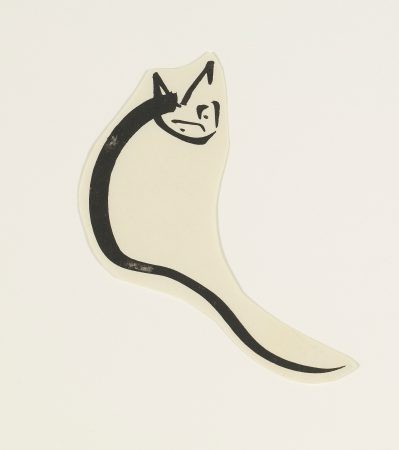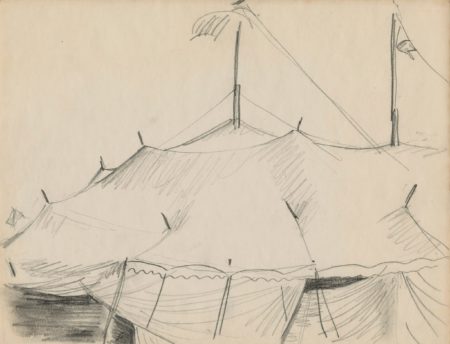Archive
See highlights from 1898–1925 on the timeline Early Development
Calder is born in Philadelphia to Nanette Lederer Calder, a painter, and Alexander Stirling Calder, a sculptor. I always thought I was born—at least my mother always told me so—on August 22, 1898. But my grandfather Milne’s birthday was on August 23, so there might
have been a little confusion. In 1942, when I wrote the Philadelphia City Hall for a birth certificate, I sent them a dollar and they told me I was born on the twenty second of July, 1898. So I sent them another dollar and told them, “Look again.” They corroborated the first statement.
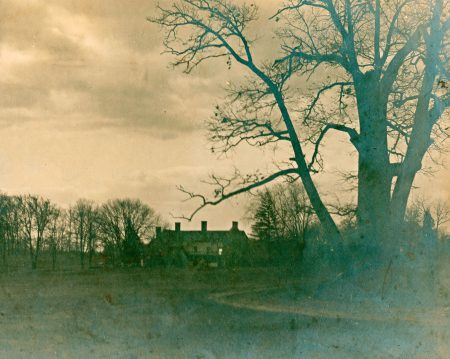
1902
Calder poses for his father’s sculpture, Man Cub, in Philadelphia. Calder sculpts his own clay elephant.
Calder 1966, 13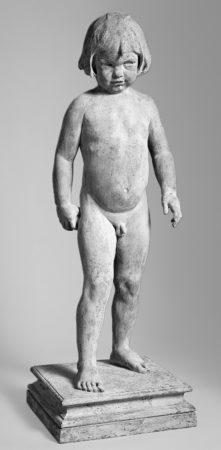
1905
Stirling Calder contracts tuberculosis. Calder’s parents move to a ranch in Oracle, Arizona, leaving Calder and his sister Peggy in the care of Dr. Charles P. Shoemaker, a dentist, and his wife, Nan.
Calder 1966, 15; Hayes 1977, 18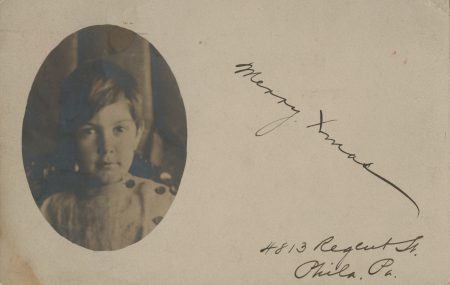
1906
Nanette picks up Calder and Peggy and they rejoin their father in Oracle. Calder befriends Riley, an elderly man recuperating at the ranch who shows him “how to make a wigwam out of burlap bags pinned together with nails.”
Calder 1966, 16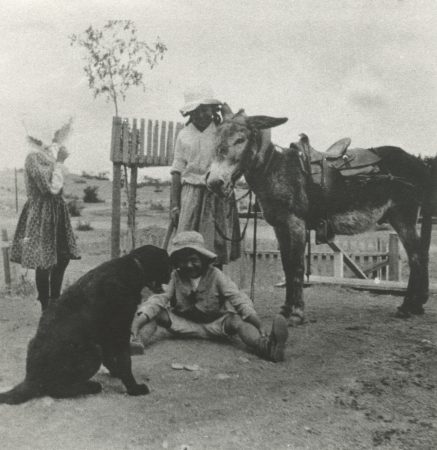
The Calders move to Pasadena, California. At that time, on Euclid Avenue in Pasadena, I got my first tools and was given the cellar with its window as a workshop. Mother and father were all for my efforts to build things myself—they approved of the
homemade . . . My workshop became some sort of a center of attraction; everybody came in.
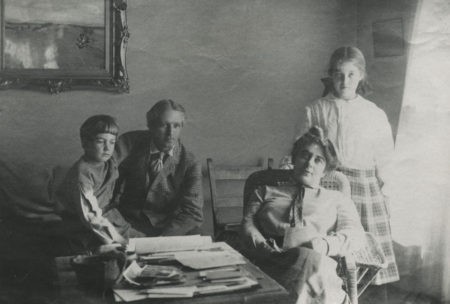
My sister had quite a few dolls for which we made extraordinary jewelry from beads and very fine copper wire that we found in the street left over by men splicing electric cables.
Calder 1952, 37Peggy once gave me a very nice pair of pliers at Christmas. I made her a little Christmas tree, completely decorated, out of a fallen branch. So she wept because my gift was homemade.
Calder 1966, 211907
Calder attends Pasadena’s Tournament of Roses, where he experiences the four-horse chariot races.
Calder 1966, 221909
The Calders move to a new house on 555 Linda Vista Avenue. Calder’s workshop consists of a tent with a wooden floor. Calder attends fourth grade at Garfield School.
CF, Nanette to Trask, 30 March; Calder 1966, 26–27The Calders return to Philadelphia. Calder attends Germantown Academy for two or three months while his parents search for a house close to New York City.
Calder 1966, 28; CF, Calder 1955–56, 7The Calders move to Croton-on-Hudson, New York. Calder has a cellar for his workshop and attends Croton Public School.
Calder 1966, 28–29For Christmas, Calder presents his parents with a dog and a duck that he trimmed from a brass sheet and bent into formation. The duck is kinetic, rocking back and forth when tapped.
Sweeney 1943, 57; Hayes 1977, 411910
For his father’s birthday, Calder makes Animal Zoo Puzzle, a game consisting of five painted animals—a tiger, a lion, and three bears—and a wooden board with nails divided into six pens. The challenge is to move the animals from their pens without having two animals in the same pen at once.
Hayes 1977, 421912
The Calders move to Spuyten Duyvil, New York. The cellar becomes Calder’s workshop. Calder and Peggy attend Yonkers High School. Stirling rents a studio in New York City on 51 West Tenth Street.
Calder 1966, 34–35Stirling is appointed as the acting chief of the department of sculpture of the Panama-Pacific International Exposition in San Francisco. He writes the introduction to The Sculpture and Mural Decorations of the Exposition, published in 1915.
Calder 1966, 36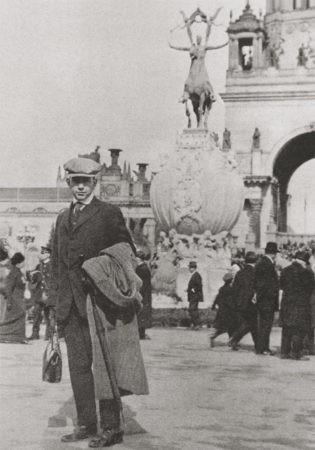
1913
The Calders move to San Francisco. Calder has a workshop in the cellar and attends Lowell High School.
Calder 1966, 36–37; Hayes 1977, 43–441915
Stirling and Nanette move to Berkeley to be near Stirling’s next commission, the Oakland Auditorium. Calder stays with the architect Walter Bliss and his wife to graduate from Lowell High School.
Calder 1966, 37–38; Hayes 1977, 52–53; CF, Calder 1955–56, 14The Calders move back to New York City on Claremont Place.
Calder 1966, 39; Hayes 1977, 55Calder begins his studies at Stevens Institute of Technology, Hoboken, New Jersey, where he takes courses that include chemistry, mechanical drawing, shop practice, and surveying, among others.
Calder 1966, 391916
Calder spends five weeks in the Plattsburg Civilian Military Training Camp, New York, drilling with Company H, Fifth Training Regiment.
Calder 1966, 461918
Calder joins the Student Army Training Corps, Naval Section, at Stevens, where he is made guide of the battalion.
Calder 1966, 481919
Calder graduates from Stevens with a degree in mechanical engineering.
CF, certificate of graduation; Lipman 1976, 329Calder holds jobs with an automotive engineer named Tracy in Rutherford, New Jersey, and with New York Edison Company as a draftsman.
Calder 1966, 48–491920
Calder joins the staff of Lumber magazine in St. Louis, Missouri. He stays for nine months.
Calder 1966, 48–501921
Calder works for Nicholas Hill, a hydraulics engineer, coloring maps for a water-supply project in Bridgeport, Connecticut. The efficiency engineers—Miller, Franklin, Basset, and Co.—hire Calder to do fieldwork for the Truscon Steel Company in Youngstown, Ohio.
Calder 1966, 49–501922
Calder attends night classes in drawing with Clinton Balmer at the New York Public School on Forty-second Street.
Calder 1966, 51Serving on the H.F. Alexander as a fireman in the boiler room, Calder sails from New York to San Francisco via the Panama Canal. It was early one morning on a calm sea, off Guatemala, when over my couch—a coil of rope—I saw the beginning of a fiery red sunrise on one side and
the moon looking like a silver coin on the other. Of the whole trip this impressed me most of all; it left me with a lasting sensation of the solar system.
Arriving in San Francisco, Calder takes a lumber schooner to Willapa Harbor, Washington, where he catches the bus for Aberdeen and meets his sister Peggy and her husband, Kenneth Hayes. Calder finds a job as a timekeeper for a logging camp in Independence, Washington.
I was supposed to make out paychecks for people. I also had to scale the logs as they were loaded on the flatcars.
Inspired by the logging camp landscape, Calder writes home and asks his mother for paints and brushes.
CF, Calder 1955–56, 39; Calder 1966, 57–581923
With the help of Stirling’s introduction, Calder seeks employment with an engineer in Canada. I went to Vancouver and called on him, and we had quite a talk about what career I should follow. He advised me to do what I really wanted to do—he himself often wished he had been an
architect. So, I decided to become a painter.
Calder writes the Kellogg Company and suggests they modify their cereal packaging, putting the wax paper on the inside rather than on the outside of the boxes. The company adopts his suggestion and sends him a note of thanks along with a case of Corn Flakes.
Hayes 1977, 76Calder returns to New York and stays with his parents at 119 East Tenth Street.
Calder 1966, 59Calder begins classes at the Art Students League of New York, studying life and pictorial composition with John Sloan and portrait painting with George Luks.
Calder 1966, 59–61, 66–67; ASL, registration records1924
Calder enrolls again at the Art Students League, taking classes in portrait painting with George Luks, head and figure with Guy Pène du Bois, a drawing class with Boardman Robinson, and an etching class.
ASL, registration recordsCalder begins his first job as an artist, illustrating sporting events and city scenes for the National Police Gazette.
Calder 1966, 67; Gazette, 3 MayCalder moves into his father’s studio, 11 East Fourteenth Street, while his parents are traveling in Europe.
Calder 1966, 66, 70; Hayes 1977, 81Calder studies life drawing with Boardman Robinson at the Art Students League.
ASL, registration records1925
A total eclipse of the sun is visible from the northern part of Manhattan. Along with thousands of New Yorkers, Calder travels uptown, stopping at the steps of Columbia University to watch. He makes The Eclipse, an oil painting of the scene.
New York Times, 24 January; CF, object fileCalder studies life drawing with Boardman Robinson at the Art Students League.
ASL, registration recordsCalder exhibits The Eclipse in the Ninth Annual Exhibition of the Society of Independent Artists at the Waldorf-Astoria, New York. In the exhibition catalogue he lists his address as 119 East Tenth Street, where he periodically lives with his parents.
CF, exhibition fileCalder spends two weeks illustrating the Ringling Bros. and Barnum & Bailey Circus for the National Police Gazette. I could tell by the music what act was getting on and used to rush to some vantage point. Some acts were better seen from above and others from below.
Calder 1966, 73; Gazette, 23 May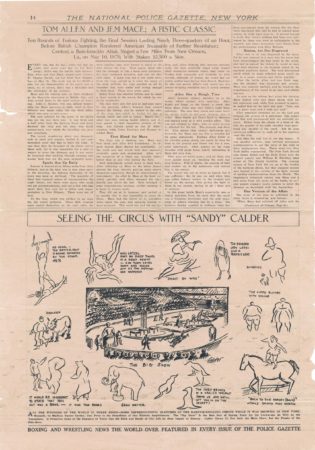
Calder makes hundreds of brush drawings of animals at the Bronx Zoo and the Central Park Zoo.
CF, object files; Sweeney 1951, 72Calder takes a lithography class with Charles Locke at the Art Students League.
ASL, registration recordsCalder travels to Florida. First he visits Miami, then Sarasota, where he sketches at the winter grounds of the Ringling Bros. and Barnum & Bailey Circus. I was very fond of the spatial relations. I love the space of the circus. I made some drawings of nothing but the tent. The whole
thing of the—the vast space—I’ve always loved it.
